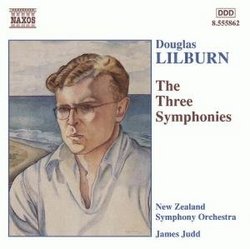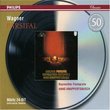| All Artists: Lilburn, Judd, New Zealand Sym Orch Title: 3 Symphonies Members Wishing: 0 Total Copies: 0 Label: Naxos Original Release Date: 1/1/2002 Re-Release Date: 7/16/2002 Genre: Classical Style: Symphonies Number of Discs: 1 SwapaCD Credits: 1 UPC: 747313586226 |
Search - Lilburn, Judd, New Zealand Sym Orch :: 3 Symphonies
 | Lilburn, Judd, New Zealand Sym Orch 3 Symphonies Genre: Classical
|
Larger Image |
CD DetailsSimilar CDs
|
CD ReviewsThe World Needs You, Douglas Lilburn! Jenny Hanniver | Philadelphia, PA, United States | 08/30/2003 (5 out of 5 stars) "The music of Douglas Lilburn, the greatest of all New Zealand composers, is beginning to come out of isolation and into the world -- and it's about time. I've long been enamored of Lilburn's Second Symphony, having discovered it on WQXR-FM, then obtaining the now out-of-print CD (on Kiwi/Stradivari) with Heenan conducting the NZSO. Judd's NZSO performance is equally exciting, and the brass chorales are as overwhelming to the senses as any of the Gabrielis'. This use of brass, although not so extended, is foreshadowed in the First Symphony. The later Third Symphony is equal to the others, although it's different in tone color and Lilburn's vision has become more introspective. I recommend all three.But it's the "brash brass" of the first two that keeps running through my head. The sheer persistence and chutzpah of Lilburn's use of brass reminds me of Nielsen's manic percussion in his Fourth Symphony. Perhaps Lilburn's music is "Nordic," as some musicologists have suggested. He is frequently compared with Sibelius, but if any Scandinavian comparison need be made it should be to Nielsen.However, I'd like to think that this outstanding music is pure New Zealand and that Lilburn owes his vision to his homeland's mountains, valleys, and towering clouds that pattern the land between episodes of shadow and brilliant sunlight. Those of us who've seen that island nation's vastness in THE LORD OF THE RINGS now know why it can evoke such fierce and beautiful passion." Nordic Kiwi. Bob Zeidler | Charlton, MA United States | 04/27/2003 (4 out of 5 stars) "A few enthusiastic on-the-web reviews of this CD, and one in Fanfare magazine, were all it took for me to give the music of Douglas Lilburn, a recently-deceased (2001) New Zealand composer, a try. (At Naxos prices, what is there to lose, anyway?) It turns out that I'm glad that I did, even though, after listening to the CD numerous times, I've come to recognize minor inaccuracies in at least one of those on-line reviews (elsewhere, not here at Amazon.com). Lilburn's music turned out to be well worth my time, in more ways than one. Despite Lilburn's having studied in England with Ralph Vaughan Williams, there is not very much in these three symphonies to suggest an obvious connection, except through very careful listening (and, clearly, a knowledge of Vaughan Williams's works). Even then, the connection is subtle and fleeting for the most part, and only truly evident in the two earlier symphonies. Elsewhere in these works, parallels to other 20th-century composers can be made, most obviously - and particularly in the two earlier works - to Jean Sibelius, Sir William Walton, Howard Hanson and Carl Nielsen (hence the "Nordic Kiwi" reference in the brief description at the top). Lilburn's three-movement First Symphony (1949) comes across as - despite his New Zealand origins - unabashedly Nordic in its "sound." The first movement is very Sibelius-like, with its building up of the work from small motivic cells, using harmonic and instrumental-color touches (woodwind pairs in thirds, for example) that remind one of the great Finn. The more brilliant parts of the movement also suggest Walton, particularly his Symphony No. 1. Several minutes into this first movement, there is a clarinet figure which reminds one of Nielsen, but then, immediately after, the thought of Sibelius returns stronger than ever. There is even a hint of very late Sibelius, say, his "Tapiola," in the movement's occasional moments of bleakness.The second movement opens in a Vaughan Williams-like pastoral mood to start, following which the alternation among Hanson, Sibelius and Nielsen seems to again dominate. The third movement again brings Vaughan Williams or Walton, as well as Sibelius, to mind. There is a brass theme reminiscent of Walton's "Crown Imperial," followed by more work reminiscent of RVW, along the lines of his "Folk Song Suite" or, perhaps, portions of his London Symphony or the more pastoral Third and Fifth Symphonies. This final movement closes in a manner that is very much Hanson-like in its neoromantic richness; it is almost a ringer for the closing moments of Hanson's own Romantic (2nd) Symphony. Much the same can be said for the four-movement Second Symphony (1951), in terms of allusions to these aforementioned composers. But the third-movement Lento invests this later work in depth of emotional intensity (reminiscent of the Largo movement of Shostakovich's Fifth Symphony) not experienced in the earlier work. Overall, it is the more engaging (and more fully-developed) work of the two. The Third Symphony (1961) represents a dramatic change in compositional aesthetic from the two earlier works from the previous decade. It is definitely sterner stuff: much more chromatic and stretching the limits of tonality almost to the edge of atonality, and with little evidence of the Nordic sound of the two earlier works. In fact, the allusions are more to William Schuman or, perhaps, Paul Hindemith, with some suggestion of Serge Prokofiev in the "Vivace" section and Béla Bartók, as in his Concerto for Orchestra, in the "Andante" section. Despite its 14-minute terseness (in one movement that Lilburn divides into five connected sections), it is a richer and more rewarding (if more challenging) work than the earlier two symphonies. Admittedly, my comments appear to describe these Lilburn symphonies as "rich in borrowed eclecticism." But, if you enjoy the works of any of the composers who seem to be alluded to in these works, you're likely to enjoy this album. The first two works will not challenge you greatly, perhaps, and Lilburn's voice is hardly what I'd characterize as "truly original," but they are tuneful and totally tonal in a way that today's neoromantic composers seem unable to achieve. Worth a listen on those grounds alone. The recording is fine; perhaps a slight bit on the congested side when listened to on speakers but seemingly clearer when heard on wide-range headphones. The New Zealand Symphony Orchestra acquits itself very well in these works (as one expects it should). The booklet notes are largely a waste, consisting of only the barest biographical materials and little of musicological merit, especially considering that for many this will be their first experience with Lilburn's music.. Anyone able to make the "Nordic" connections that I (and other reviewers) have made, with little trouble at all, will be frustrated by the fact that the notes say little about Lilburn's music and its possible influences and inspirations beyond the fact that he studied with Vaughan Williams. A recent news article on Klaus Heymann, the founder/owner of Naxos, states that he lives in New Zealand and no longer oversees the Naxos operation with the same day-to-day attention to detail that he earlier did, in establishing the label's reputation. And it shows. To me, it seems as if he had little if any direct role in championing this release; it doesn't have his characteristic "fingerprints" for notational detail and scholarship. (By contrast, the Naxos booklet notes for the recent "critical edition" recordings of the Charles Ives 2nd and 3rd Symphonies, by Kenneth Schermerhorn and James Sinclair respectively, are models of musicological clarity and comprehensiveness.) As a result, I feel as if I can give this release only four stars, despite the novelty of the music, as well as its performance, being reasonably meritorious. Bob Zeidler" Highly Interesting Symphonies D. A Wend | Buffalo Grove, IL USA | 09/19/2002 (5 out of 5 stars) "I had not heard of Douglas Lillburn before the release of this disc. I became interested after reading reviews of this disc. His symphonies are highly interesting and although there may not be a melody that you remember, his musical ideas make great listening. Lillburn was from New Zealand and studied music in England, most notably with Ralph Vaughan Williams. His music has been compared to Sibelius and Vaughan Williams but, for me, there is a lot of Walton in his approach to orchestration. One review I read suggested that the Third Symphony was a bit difficult and abrasive at first hearing but I did not find this to be the case. The Second Symphony was inspired by Lillburn's love of nature. In this symphony he sonically gives his impressions of the landscape of New Zealand that is especially expressive. The New Zealand Symphony Orchestra play the symphonies beautifully, and the recording is superb. I highly recommend this disc of very approachable modern music."
|

 Track Listings (8) - Disc #1
Track Listings (8) - Disc #1


